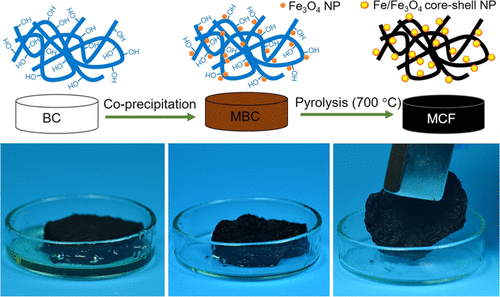当前位置:
X-MOL 学术
›
ACS Appl. Nano Mater.
›
论文详情
Our official English website, www.x-mol.net, welcomes your feedback! (Note: you will need to create a separate account there.)
Carbon Nanofiber Aerogel/Magnetic Core–Shell Nanoparticle Composites as Recyclable Oil Sorbents
ACS Applied Nano Materials ( IF 5.9 ) Pub Date : 2020-04-02 , DOI: 10.1021/acsanm.0c00818 Pimchanok Ieamviteevanich 1 , Dulyawich Palaporn 1 , Narong Chanlek 2 , Yingyot Poo-arporn 2 , Wiyada Mongkolthanaruk 3 , Stephen J. Eichhorn 4 , Supree Pinitsoontorn 1, 5
ACS Applied Nano Materials ( IF 5.9 ) Pub Date : 2020-04-02 , DOI: 10.1021/acsanm.0c00818 Pimchanok Ieamviteevanich 1 , Dulyawich Palaporn 1 , Narong Chanlek 2 , Yingyot Poo-arporn 2 , Wiyada Mongkolthanaruk 3 , Stephen J. Eichhorn 4 , Supree Pinitsoontorn 1, 5
Affiliation

|
Developing sorbent materials for the removal of oil spills has become an attractive research topic in recent years for its impact on environmental and ecological concerns. The sorbents should be light, low cost, oil selective, environmentally friendly, mechanically robust, easily collected, and recyclable, besides having high absorption capacities. Here, magnetic carbon nanofiber (MCF) aerogels have been developed from bacterial cellulose-based nanocomposites as efficient and recyclable oil sorbents. The MCF aerogels comprise a three-dimensional (3D) interconnected structure of carbon nanofibers, with very high porosity, decorated with uniformly dispersed magnetic nanoparticles (NPs), with an Fe/Fe3O4 core–shell structure. The MCF aerogels exhibit very high magnetization (>100 emu g–1), compared to other previously reported magnetic aerogels, due to the Fe core/Fe3O4 shell NPs, but additionally with an ultralow density of only ∼7 mg cm–3. Furthermore, the MCF aerogel is highly compressible up to 90% strain and instantly returns to the original shape after release without any plastic deformation. It is also highly durable, up to 100 compressive stress–strain cycles. As for oil sorbents, the MCF aerogel can absorb oils directly without any postsurface treatment, due to its hydrophobic/oleophilic property. The absorption capacities are in the range of 37–87 g g–1 for various types of oils and organic solvents. These values are comparably large among magnetic carbon aerogels. Additionally, due to their large magnetization, the MCF aerogels can be easily manipulated during oil absorption and collected via external magnetic fields, which is beneficial for avoiding direct contact with possible hazardous solvents. They can then be recycled several times by dissolution with hardly any reduction in absorption capacity. This work has demonstrated that environmentally friendly biomass-derived MCF aerogels could be candidates for the absorption and recycling of oils and organic solvents from wastewater.
中文翻译:

碳纳米纤维气凝胶/磁性核-壳纳米颗粒复合材料作为可回收的油吸收剂
近年来,开发用于去除溢油的吸附剂材料已成为有吸引力的研究课题,因为它对环境和生态问题具有影响。吸附剂除具有高吸收能力外,还应轻质,低成本,对油具有选择性,对环境友好,机械坚固,易于收集和可回收利用。在这里,磁性碳纳米纤维(MCF)气凝胶已由细菌纤维素基纳米复合材料开发成为有效且可回收的吸油剂。MCF气凝胶包括碳纳米纤维的三维(3D)互连结构,具有很高的孔隙率,装饰有均匀分散的磁性纳米颗粒(NP),具有Fe / Fe 3 O 4核-壳结构。MCF气凝胶具有很高的磁化强度(> 100 emu g–1),与以前报道的其他磁性气凝胶相比,归因于Fe核/ Fe 3 O 4壳纳米颗粒,但其超低密度仅为〜7 mg cm –3。此外,MCF气凝胶在高达90%的应变下具有很高的可压缩性,释放后可立即恢复原始形状,而不会发生任何塑性变形。它也非常耐用,可承受100次压缩应力-应变循环。对于油类吸附剂,由于其疏水性/亲油性,MCF气凝胶无需任何后表面处理即可直接吸收油类。吸收能力在37–87 gg –1的范围内用于各种类型的油和有机溶剂。这些值在磁性碳气凝胶中比较大。此外,由于MCF气凝胶具有较大的磁化强度,因此在吸油过程中易于操作,并可以通过外部磁场收集,这有利于避免与可能的有害溶剂直接接触。然后可以通过溶解将它们再循环几次,而吸收能力几乎没有降低。这项工作表明,环保的生物质衍生的MCF气凝胶可以作为废水中油类和有机溶剂的吸收和再循环的候选者。
更新日期:2020-04-02
中文翻译:

碳纳米纤维气凝胶/磁性核-壳纳米颗粒复合材料作为可回收的油吸收剂
近年来,开发用于去除溢油的吸附剂材料已成为有吸引力的研究课题,因为它对环境和生态问题具有影响。吸附剂除具有高吸收能力外,还应轻质,低成本,对油具有选择性,对环境友好,机械坚固,易于收集和可回收利用。在这里,磁性碳纳米纤维(MCF)气凝胶已由细菌纤维素基纳米复合材料开发成为有效且可回收的吸油剂。MCF气凝胶包括碳纳米纤维的三维(3D)互连结构,具有很高的孔隙率,装饰有均匀分散的磁性纳米颗粒(NP),具有Fe / Fe 3 O 4核-壳结构。MCF气凝胶具有很高的磁化强度(> 100 emu g–1),与以前报道的其他磁性气凝胶相比,归因于Fe核/ Fe 3 O 4壳纳米颗粒,但其超低密度仅为〜7 mg cm –3。此外,MCF气凝胶在高达90%的应变下具有很高的可压缩性,释放后可立即恢复原始形状,而不会发生任何塑性变形。它也非常耐用,可承受100次压缩应力-应变循环。对于油类吸附剂,由于其疏水性/亲油性,MCF气凝胶无需任何后表面处理即可直接吸收油类。吸收能力在37–87 gg –1的范围内用于各种类型的油和有机溶剂。这些值在磁性碳气凝胶中比较大。此外,由于MCF气凝胶具有较大的磁化强度,因此在吸油过程中易于操作,并可以通过外部磁场收集,这有利于避免与可能的有害溶剂直接接触。然后可以通过溶解将它们再循环几次,而吸收能力几乎没有降低。这项工作表明,环保的生物质衍生的MCF气凝胶可以作为废水中油类和有机溶剂的吸收和再循环的候选者。


























 京公网安备 11010802027423号
京公网安备 11010802027423号